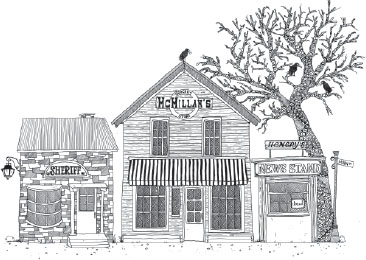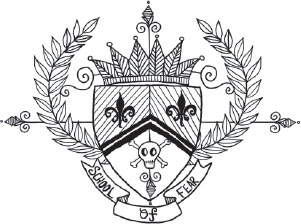CHAPTER 4
EVERYONE’S AFRAID OF
SOMETHING:
Agyrophobia is the fear of crossing the street.

Hidden deep within a rural pocket in Northwestern Massachusetts was a small town known as Farmington. For a lucky four hundred and four people, twenty-eight dogs, forty-nine cats, and six horses it was home. While there were many other creatures from squirrels to turtles living in the town, they weren’t registered with the county and, therefore, didn’t make the yearly census.
Farmington was oddly untouched by time. Missing were any signs of corporate America such as Wal-Mart, Starbucks, or McDonald’s. Instead, each shop was privately owned with hand-painted signs to prove it. There was one main street, rather straightforwardly called Main Street, on which sat McMillan’s Grocery Store, the post office, Henry’s newsstand, Farmy’s diner, and the sheriff’s office.
Nearly all of the four hundred and four human residents (and many of the animal ones) lived on the roads surrounding Main Street, creating an extremely tight-knit community. A few people inhabited the surrounding wilderness, only sporadically venturing into town for mail and provisions. The ever-elusive headmistress of the School of Fear, Mrs. Wellington, and her caretaker, Schmidty, lived the farthest from town, atop a four-acre plateau with two-hundred-foot protective granite cliffs on all sides. Scientists supposed the unusual granite mountain was the result of a glacier from the Cretaceous Period, which was approximately a really, really long time ago.
Mrs. Wellington’s estate, Summerstone, acted as a beacon in the Lost Forest. Upon hearing the name Lost Forest, one might wonder how a forest could get lost. It doesn’t walk, run, or skip, and one would assume it’s too large for a park ranger to miss. In this case, lost does not refer to the forest itself, but rather to anyone or anything that enters it.
The townsfolk in Farmington referred to the Lost Forest as their very own Bermuda Triangle. At the request of park rangers, it was long closed with many NO TRESPASSING signs posted around the perimeter. The only two things that dared cross the forest were the Moon River and a scarcely used cobblestone road, which led straight to the base of Summerstone’s Mountain.
Harold Wellington built Summerstone in 1952 as an isolated retreat for his wife, Edith. The eight-bedroom manor surrounded by persimmon, fig, orange, and cherry trees was located squarely in the center of the grounds. Mr. Wellington had spared no expense in the construction of Summerstone or its lavish decoration.
Rumors abounded of golden latrines and platinum light switches resting beside Renoirs or Monets, but none of it was true. Mrs. Wellington was far too eclectic and peculiar to indulge in such noticeably grand items. She much preferred to commission one-of-kind pieces such as tortoiseshell tables and portraits of her pets. Regardless of Mrs. Wellington’s offbeat taste, Summerstone was the grandest structure Farmington had ever seen. Unfortunately, the locals were only able to admire the architecturally mesmerizing building from a distance, as Mrs. Wellington did not take kindly to visitors.
